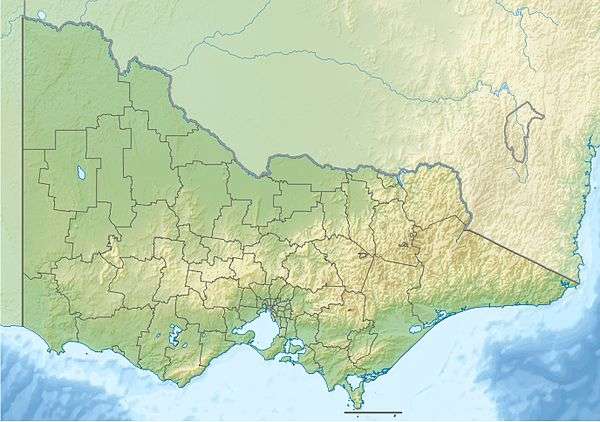Cardinia Reservoir
| Cardinia Dam | |
|---|---|
|
The control tower and dam walls near the embankment | |
 Location of the Cardinia Reservoir in Victoria | |
| Country | Australia |
| Location | Greater Melbourne, Victoria |
| Coordinates | 37°58′17″S 145°25′8″E / 37.97139°S 145.41889°ECoordinates: 37°58′17″S 145°25′8″E / 37.97139°S 145.41889°E |
| Purpose | Water supply |
| Status | Operational |
| Construction began | May 1970 |
| Opening date | 1973 |
| Construction cost | A$11.4 million |
| Owner(s) | Melbourne Water |
| Dam and spillways | |
| Type of dam | Embankment dam |
| Impounds | Cardinia Creek |
| Height (foundation) | 86 m (282 ft) |
| Length | 1,542 m (5,059 ft) |
| Dam volume | 5,150×103 m3 (182×106 cu ft) |
| Spillways | 1 |
| Spillway type | Uncontrolled |
| Spillway capacity | 12 m3/s (420 cu ft/s) |
| Reservoir | |
| Creates | Cardinia Reservoir |
| Total capacity | 286,910 ML (6.311×1010 imp gal; 7.579×1010 US gal) |
| Catchment area | 2,800 ha (6,900 acres) |
| Surface area | 1,295 ha (3,200 acres) |
| Normal elevation | 494 m (1,621 ft) AHD |
| Power station | |
| Name | Cardinia Dam Power Station |
| Coordinates | 37°57′6″S 145°23′54″E / 37.95167°S 145.39833°E |
| Operator(s) | Pacific Energy |
| Annual generation | 3.5 MW (4,700 hp) |
|
Website Cardinia Reservoir at Melbourne Water | |
| [1] | |
Cardinia Reservoir is an Australian man-made water supply dammed reservoir. The 287,000-megalitre (6.3×1010 imp gal; 7.6×1010 US gal) water store is located in Emerald-Clematis-Dewhurst in south-eastern suburbs of Melbourne, Victoria. Construction started in May 1970 and was completed in 1973 at a cost of more than A$11.4 million.[2][3][4][5][6] The dam that creates the impoundment is called the Cardinia Dam.
History
As Melbourne's water supplies struggled through the 1960s the need for additional water storage became evident. Cardinia Creek ran from the Dandenong Ranges to Western Port Bay, passing through some small but well defined hills south of the outer suburb of Emerald. This site was chosen as being suitable for a new reservoir. In 1966, plans for the construction of the Cardinia and Thomson Reservoirs were accepted by the Government of Victoria. Construction of the Tarago Reservoir commenced in 1966 and was completed in 1969. This water storage was built by the State Rivers and Water Supply Commission of Victoria (SR&WSC) to improve the capacity of the water supply system to meet the ever increasing demand for water in the district. By 1967, Melbourne struggled through a severe drought and water restrictions were imposed in the summer of 1967–68. As a result, plans for construction of Cardinia and Thomson Reservoirs were advanced.[3]
With the construction of one large rolled earthfill and rockfill embankment to serve as the Cardinia Dam wall, and some other saddle dams in nearby hills, the large water storage facility of the Cardinia Reservoir was created.[7] The dam was built by Fluor Construction, and engineered by Snowy Mountains Engineering Corporation, under contract to the Melbourne Metropolitan Board of Works (MMBW).[1] The dam wall height is 86 metres (282 ft) and the main embankment is 1,542 metres (5,059 ft) long. The two saddle dams are 10 metres (33 ft) high and 323 metres (1,060 ft) long; and 16 metres (52 ft) high and 1,219 metres (3,999 ft) long respectively. At 100% capacity the dam wall was designed to hold back 286,910 megalitres (6.311×1010 imp gal; 7.579×1010 US gal) of water. The surface area of Cardinia Reservoir is 1,295 hectares (3,200 acres) and the catchment area is 2,800 hectares (6,900 acres). The ungated uncontrolled spillway is capable of discharging 12 cubic metres per second (420 cu ft/s).[1]
Construction of the dam was completed in 1973, following which it took another four years to fill, including substantial water transfers from Silvan Reservoir. As part of the Victorian Government's policy that fluoride should be added to all public water supplies, construction began on local fluoridation plants.[3] In 1981, following continued demand for potable water on the Mornington Peninsula finally exceeded the district's ability to meet its own water supply needs. Despite upgrading of existing facilities, water from the MMBW reservoir at Cardinia was first used to supplement local water supplies.[3] Export of "Australia Pure", a bottled water from Cardinia Reservoir, commenced in 1993 to several European countries and the United States of America.[3]
The surrounds of the reservoir were allocated $1 million for landscaping work to create a recreational area including picnic areas, playgrounds, carparks, and walking tracks.[7][8]
Operations
Cardinia receives water via a pipeline from Silvan Reservoir. A 3.5-megawatt (4,700 hp) hydroelectric power station at the outlet of the pipeline generates electricity as water is transferred to Cardinia. Water from Cardinia supplies Melbourne's southern and south-eastern suburbs, and the Mornington Peninsula.
The Cardinia Reservoir is managed by Melbourne Water.[9]
Gallery

See also
References
- 1 2 3 "Register of Large Dams in Australia" (Excel (requires download)). Dams information. Australian National Committee on Large Dams. 2010. Retrieved 22 March 2014.
- ↑ Cardinia Dam, Aaron and John, History of Emerald, Emerald Primary School Website
- 1 2 3 4 5 "History of Melbourne's water supply". Official Website. Yarra Valley Water.
- ↑ Melbourne Water : water supply : history
- ↑ Melbourne Water : Publications : Fact Sheets : Water : Cardinia Reservoir
- ↑ Cardinia Dam will double water, Page 18, The Age - Apr 24, 1972
- 1 2 "Cardinia Reservoir Park". Official Website. Parks Victoria. 2010. Retrieved 17 January 2011.
- ↑ "R J Chambers Trail" (PDF). Notes. Victorial Govt.
- ↑ "Cardinia Reservoir". Melbourne Water.
External links
| Wikimedia Commons has media related to Cardinia Reservoir. |
- Cardinia Reservoir Park, Parks Victoria
- Cardinia Reservoir and Catchment, Cardinia Reservoir Park – Information Kit, March 2003, Parks Victoria
